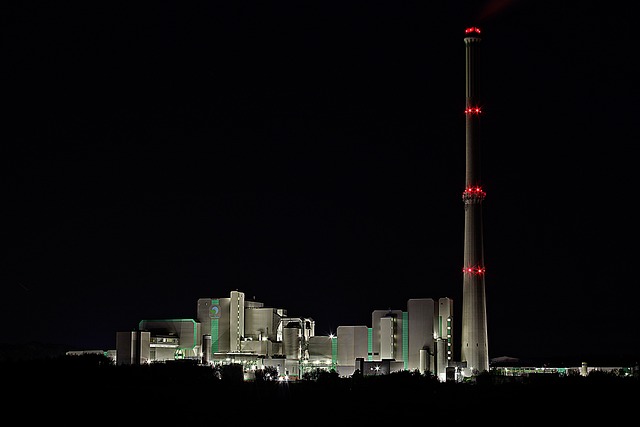Combustion is a chemical reaction with oxygen, while incineration is controlled burning of waste to reduce volume and harm.
Combustion Vs. Incineration
Combustion, in simple terms, is the process of burning a substance in the presence of oxygen to produce heat and light. It is a natural process that occurs in various forms, from a small flame to a large-scale fire. In combustion, the main focus is on the release of energy. This process is widely used for heating, cooking, and power generation.
Incineration is a controlled and intentional process specifically designed for waste management. It involves the combustion of waste materials at high temperatures to reduce their volume and convert them into ash, gas, and heat. Incineration is used to minimize the environmental impact of waste disposal and can be applied to various types of waste, including municipal solid waste, medical waste, and hazardous waste.
Understanding Combustion and Incineration
Combustion and incineration are two processes that involve the burning of materials, but they differ in their objectives and the way they are carried out. Here is a breakdown of the differences between combustion and incineration:
- Purpose: Combustion is a natural process of burning fuel to produce heat or energy. It is commonly used for heating, cooking, or powering engines. On the other hand, incineration is a controlled process specifically designed for waste disposal, where waste materials are burned at high temperatures to reduce their volume and eliminate potential hazards.
- Materials: Combustion can involve a wide range of materials, including fossil fuels, wood, or gases. It focuses on the efficient release of energy through the oxidation of these materials. Incineration, on the other hand, is primarily used for the disposal of solid waste materials, such as household waste, medical waste, or hazardous waste.
- Environmental Impact: Combustion of fossil fuels for energy production can contribute to air pollution and the release of greenhouse gases. Modern combustion technologies aim to minimize these impacts through advanced emission control systems. Incineration, when properly managed and equipped with pollution control devices, can also minimize environmental impacts by reducing the volume of waste and controlling emissions.
- Temperature: Combustion processes typically operate at lower temperatures compared to incineration. Incineration processes require higher temperatures to ensure complete combustion and proper waste treatment. These high temperatures help destroy harmful substances and pathogens in the waste.
- Control and Regulation: Combustion for energy production is regulated by various environmental standards to control emissions and ensure proper air quality. Incineration, being a waste management process, is subject to even more stringent regulations and monitoring to protect public health and the environment.
- Residue: Combustion processes may produce ash as a residue, particularly when burning solid fuels. Incineration, on the other hand, produces ash as well as other byproducts like gases and particulate matter. These byproducts undergo additional treatment and disposal to minimize their potential environmental impact.
By understanding the differences between combustion and incineration, we can better appreciate their distinct purposes and the importance of implementing appropriate technologies and regulations to mitigate their potential environmental and health impacts.
What is Combustion?

Combustion is a chemical reaction that occurs when a fuel combines with oxygen, resulting in the release of heat, light, and various combustion byproducts. The process of combustion involves the rapid oxidation of the fuel, which can be a solid, liquid, or gas, in the presence of oxygen. Here are key aspects of combustion:
- Fuel: Combustion requires a fuel source, which can include fossil fuels like coal, oil, and natural gas, as well as renewable fuels like wood, biomass, and biofuels.
- Oxygen: The presence of oxygen is necessary for combustion to take place. It acts as an oxidizing agent, reacting with the fuel to release energy.
- Heat: Combustion is an exothermic reaction, meaning it releases heat energy. The heat generated during combustion is what sustains and accelerates the reaction.
- Ignition Temperature: Every fuel has an ignition temperature, the minimum temperature at which it can spontaneously ignite and sustain combustion. Once the ignition temperature is reached, the combustion reaction becomes self-sustaining.
- Combustion Products: When fuel undergoes combustion, it produces various combustion byproducts, including carbon dioxide (CO2), water vapor (H2O), nitrogen oxides (NOx), sulfur dioxide (SO2), and particulate matter.
- Applications: Combustion is widely used for energy production, such as in power plants, heating systems, and engines. It is also essential for cooking, transportation, and other industrial processes.
- Efficiency and Emissions: The efficiency of combustion can vary depending on factors like the fuel type, combustion conditions, and equipment used. Efforts are made to improve combustion efficiency and reduce emissions of pollutants through technologies like catalytic converters and scrubbers.
Combustion is a chemical process that involves the rapid oxidation of a fuel in the presence of oxygen, resulting in the release of heat and various combustion byproducts.
Definition of Combustion
Combustion, also known as burning, can be defined as a chemical process in which a fuel combines with oxygen to produce both heat and light energy. This exothermic reaction is responsible for releasing energy in the form of heat and light. During the process of combustion, the fuel undergoes a rapid oxidation reaction, resulting in the creation of new chemical compounds.
When it comes to energy production, combustion is widely utilized to generate heat. This heat can then be used to produce steam, which in turn can drive turbines for the purpose of electricity generation. Combustion is also commonly employed in engines found in cars and airplanes. In these engines, the fuel is burned, or combusted, to create the necessary energy for propulsion.
For the process of combustion to occur, three essential elements are needed: fuel, oxygen, and heat. The fuel serves to provide carbon and hydrogen atoms, while oxygen is required for the oxidation process. Heat is crucial in order to initiate and sustain the reaction. Without any one of these elements, combustion simply cannot take place.
The primary objective of combustion is to convert the potential energy stored in the fuel into useful heat energy. This heat can serve a variety of purposes, including cooking, heating buildings, and generating electricity. Combustion plays a crucial role in numerous industries and is an integral part of our daily lives.
In summary, combustion is a chemical process that involves the rapid reaction of a fuel with oxygen. This reaction releases both heat and light energy. It is a fundamental process utilized in a wide range of applications, from energy production to transportation, and it plays a vital role in powering our modern world.
How Does Combustion Occur?
Combustion occurs through a process called oxidation, which involves the chemical reaction between a fuel source and oxygen. How Does Combustion Occur? As the fuel combines with oxygen, it releases energy in the form of heat and light. This reaction is exothermic, meaning it releases more energy than it absorbs.
During combustion, the fuel undergoes rapid oxidation, breaking its chemical bonds and releasing various byproducts such as carbon dioxide, water vapor, and other gases. These byproducts are the result of the fuel’s molecular structure and the specific elements it contains.
Temperature plays a crucial role in combustion. How Does Combustion Occur? In order for combustion to occur, the fuel must reach its ignition temperature – the minimum temperature required for the fuel to ignite and sustain the reaction. Once ignition occurs, the heat produced in the combustion process allows for continuous fuel oxidation.
Combustion can occur in different environments, including open air or in controlled systems like engines or furnaces. How Does Combustion Occur? The specific conditions, fuel type, and available oxygen will influence the combustion process and the resulting products.
Understanding how combustion occurs is essential for various industries, including energy production, transportation, and manufacturing. How Does Combustion Occur? It allows for the efficient utilization of fuel sources and the development of combustion technologies that aim to minimize environmental impact.
Combustion occurs through the oxidation of fuel in the presence of oxygen, resulting in the release of heat, light, and various byproducts. How Does Combustion Occur? Temperature, fuel type, and oxygen availability are key factors influencing the combustion process.
Types of Combustion
To gain a comprehensive understanding of combustion, it is essential to examine the various types of combustion that exist. This can be effectively demonstrated through the use of a table:
| Type | Description |
|---|---|
| Premixed Combustion | This form of combustion occurs when the fuel and oxidizer are combined prior to ignition. Examples include gasoline engines and gas stoves. |
| Diffusion Combustion | In diffusion combustion, the fuel and oxidizer are not mixed before ignition. Instead, they react at the interface where they come into contact. This type of combustion is commonly found in diesel engines. |
| Partial Combustion | Partial combustion refers to a situation where there is insufficient oxygen for complete combustion to take place. This can result in the creation of pollutants such as carbon monoxide. |
| Homogeneous Combustion | Homogeneous combustion occurs when the fuel and oxidizer are evenly mixed throughout the combustion area. This leads to a more uniform and continuous combustion process. |
| Heterogeneous Combustion | Heterogeneous combustion happens when the fuel and oxidizer are not uniformly mixed, leading to uneven combustion patterns. Examples include solid fuel combustion and combustion in engines with fuel injectors. |
Comprehending the different types of combustion is crucial in various fields, including energy production, environmental studies, and fire safety. By studying these different types, scientists and engineers can develop more efficient combustion processes, reduce emissions, and enhance overall combustion performance.
Throughout history, humans have utilized the power of combustion for various purposes. From the discovery of fire by early humans to the advancements in combustion engines during the Industrial Revolution, combustion has played a significant role in shaping human civilization. Over time, our understanding of combustion has advanced, resulting in improved technologies and more sustainable practices. Today, ongoing research and development continue to expand our knowledge of combustion, enabling us to utilize this powerful process in a more efficient and environmentally friendly manner.
What is Incineration?

Incineration refers to the process of burning waste materials at high temperatures until they are reduced to ash or gas. It is a method of waste disposal that is commonly used to manage and reduce the volume of solid waste. Here are key aspects of incineration:
- Waste Treatment: Incineration is primarily used for disposing of various types of waste, including municipal solid waste, hazardous waste, medical waste, and industrial waste. The process aims to reduce the volume of waste, eliminate pathogens, and recover energy when possible.
- High Temperatures: Incinerators operate at high temperatures typically ranging from 800 to 1,200 degrees Celsius (1,472 to 2,192 degrees Fahrenheit). These high temperatures ensure efficient combustion and help break down waste into ash and gases.
- Air Pollution Control: To minimize the release of harmful pollutants into the atmosphere, modern incinerators employ various air pollution control technologies. These technologies, such as scrubbers, filters, and electrostatic precipitators, remove pollutants like particulate matter, heavy metals, and dioxins.
- Energy Recovery: Incineration can be utilized to recover energy from the waste being burned. Heat generated during the process can be used to produce steam, which in turn can generate electricity or be used for heating purposes.
- Residue Management: The ash remaining after incineration, known as bottom ash, is typically collected and disposed of separately. It may undergo further treatment or be sent to a landfill. Incineration can also produce flue gas, which undergoes additional treatment to remove pollutants before being released into the atmosphere.
- Regulations and Guidelines: Incineration facilities are subject to strict regulations and guidelines to ensure proper waste management, prevent pollution, and protect human health and the environment. Compliance with emission standards and environmental permits is essential to operate an incineration facility.
Incineration offers a waste management solution that can reduce the volume of waste, recover energy, and control air pollution. It is important to implement proper technologies and adhere to environmental regulations to minimize the potential negative impacts of the process.
Definition of Incineration
Incineration is the process of burning waste materials in a controlled manner to reduce their volume and convert them into ash, gas, and heat. The definition of incineration refers to the controlled burning of waste materials to reduce volume and convert them into ash, gas, and heat. This method is often used to manage and dispose of various types of waste, including household and medical waste, as well as hazardous materials.
In the incineration process, waste materials are burned at high temperatures, typically ranging from 500 to 1,000 degrees Celsius. This high heat helps to break down the waste into its basic components and destroy any harmful substances or pathogens present. As a result, incineration can be an effective means of reducing the volume of waste and minimizing its potential impact on the environment.
There are different types of incineration, including mass burn, modular, and fluidized bed incineration. Each method has its unique features and advantages depending on the type of waste being treated and the specific requirements of the incineration facility.
It is important to note that incineration is subject to strict regulations to ensure that the process is carried out safely and does not pose harm to human health or the environment. Advanced technologies and emission control systems are used to minimize air and water pollution and to capture potentially harmful substances released during the incineration process.
How Does Incineration Work?
Incineration is a process used to efficiently dispose of solid waste by burning it at high temperatures. Here is a brief explanation of how incineration works:
- Combustion Chamber: The waste is fed into a large combustion chamber, where it undergoes combustion, which is how the process of burning takes place. This chamber is designed to withstand the high temperatures generated during incineration.
- Heat Generation: The waste is ignited, either by direct heat or by burners, and the combustion process produces a significant amount of heat. This heat is used to generate steam, which can be used to produce electricity or heat buildings.
- Waste Reduction: As the waste burns, it undergoes chemical reactions and is transformed into ash and gases. The high temperatures of incineration help break down organic matter and reduce the volume of the waste. This results in a significant reduction in the amount of waste that needs to be disposed of.
- Air Pollution Control: Incineration can release pollutants into the air, such as particulate matter and harmful gases. To mitigate these emissions, modern incinerators are equipped with advanced air pollution control systems, including filters and scrubbers, to remove harmful substances and ensure compliance with environmental regulations.
- Residue Management: The ash and other solid residues left after combustion, known as bottom ash and fly ash, are collected and treated separately. These residues may contain trace amounts of heavy metals and other pollutants, so they must be properly managed and disposed of in accordance with regulations.
By understanding how incineration works, we can evaluate its effectiveness and potential impact on waste management and the environment.
Types of Incineration
| Types of Incineration | Description |
| Mass Burn Incineration | This type of incineration involves burning solid waste without any pre-treatment. The waste is directly fed into the incinerator, where it is burned at high temperatures. Mass burn incineration is commonly used for mixed municipal solid waste and can handle large volumes of waste. |
| Refuse-Derived Fuel Incineration | In refuse-derived fuel incineration, solid waste is first sorted and processed, removing recyclables and non-combustible materials. The remaining combustible materials are then shredded to create refuse-derived fuel (RDF), which is burned in the incinerator. This type of incineration is more efficient and produces less ash compared to mass burn incineration. |
| Fluidized Bed Incineration | Fluidized bed incineration involves suspending waste particles in a bed of hot sand or other inert material. The waste is combusted within the fluidized bed, which provides efficient mixing of fuel and air, resulting in complete combustion. This type of incineration is suitable for a wide range of waste types, including hazardous and medical waste. |
| Pyrolysis | Pyrolysis is a thermal decomposition process where waste materials are heated in the absence of oxygen. This leads to the production of gases, liquids, and solid residues. The gases and liquids can be used as energy sources, while the solid residues can be further processed or disposed of. Pyrolysis is often used for the treatment of organic waste. |
| Gasification | Gasification involves the conversion of solid waste into a mixture of gases known as syngas. The syngas can be used as a fuel for generating electricity or for other industrial processes. Gasification is a more advanced form of incineration that allows for the recovery of energy from waste while reducing environmental impacts. |
Key Differences Between Combustion and Incineration
Discover the fascinating disparities between combustion and incineration in this section. We’ll delve into the purpose, process, and mechanisms behind these two methods, as well as their implications for waste management and the environment. Uncover the key factors that differentiate combustion from incineration, and gain a deeper understanding of the distinct roles they play in various contexts. Get ready for an insightful exploration of these crucial distinctions.
Purpose
Combustion and incineration serve different purposes in waste management.
1. The purpose of combustion is to generate energy. It is a chemical reaction between fuel and oxygen that produces heat, light, and various combustion byproducts. Combustion is commonly used in power plants and engines to generate electricity or run vehicles. By burning waste materials, combustion reduces the volume of waste and produces energy that can be used for various purposes.
2. In contrast, the purpose of incineration is to safely dispose of waste materials. Incineration involves the controlled burning of waste at high temperatures, typically in specialized incinerators. This process is specifically designed to minimize the release of harmful gases and pollutants into the environment. Incineration is widely utilized for medical waste, hazardous chemicals, and other non-recyclable materials.
Fact: Incineration can reduce the volume of solid waste by up to 90% and generate heat that can be used in district heating systems or converted into electricity. It is crucial to ensure proper air pollution control measures are in place to minimize the environmental impact of incineration processes.
Process and Mechanism
The process and mechanism of combustion and incineration can be understood by following these steps:
- Combustion:
- Fuel and oxygen are needed for the combustion process to occur.
- Combustion occurs through chemical reactions between the fuel and oxygen, resulting in the release of heat and light energy.
- During combustion, the fuel molecules break down into simpler compounds like carbon dioxide and water.
- The released heat energy can be utilized for various purposes, including heating or powering engines.
- Incineration:
- Incineration serves as a specialized form of combustion primarily used for waste disposal.
- It involves burning solid waste at high temperatures.
- The waste is introduced into a furnace or incinerator, subjecting it to intense heat.
- As a result, the waste breaks down into ash, gases, and heat energy.
- To minimize pollutants, the gases produced during incineration may undergo further treatment before being released into the atmosphere.
Fact: The incineration process can significantly reduce waste volume, often by up to 90%. This makes it a more space-efficient method of waste disposal compared to traditional landfilling.
By understanding the process and mechanism of combustion and incineration, we can gain a better appreciation for their role in energy production and waste management.
Waste Management
Waste management is a pivotal aspect of both combustion and incineration processes. In combustion, waste materials undergo combustion at elevated temperatures to generate heat and energy. The waste is meticulously handled and disposed of in accordance with stringent guidelines and regulations to ensure proper waste management. Combustion facilities are equipped with advanced systems to control and minimize emissions, thereby ensuring that the waste is managed responsibly from an environmental standpoint.
Similarly, incineration also entails the controlled burning of waste materials. The incineration process is specifically tailored to decrease the volume and toxicity of the waste. Through meticulous waste management practices, such as segregation and treatment, incineration facilities strive to maximize energy recovery and minimize the environmental impact of the waste.
Both combustion and incineration processes necessitate effective waste management strategies to guarantee the safe handling, disposal, and treatment of waste materials. This encompasses measures such as appropriate storage, transportation, and continuous monitoring of waste throughout the entire process. Rigorous waste management practices are implemented to safeguard the environment and public health, thereby minimizing the potential release of harmful pollutants.
By implementing efficient waste management measures, both combustion and incineration contribute to the overall sustainability of waste disposal. These processes aid in reducing the volume of waste while recovering valuable resources and generating energy. It is crucial to continuously enhance waste management practices and explore alternative methods to further augment the efficiency and environmental performance of waste treatment and disposal systems.
Environmental Impact
The environmental impact of combustion and incineration is a crucial consideration in waste management. Both of these processes release harmful pollutants into the air, including carbon dioxide, nitrogen oxides, and particulate matter, which contribute to air pollution. The adverse effects of these pollutants on human health and the environment cannot be underestimated. However, incineration, unlike traditional combustion methods, is subject to stricter regulations and emission control technologies, resulting in reduced air pollution. Nonetheless, incineration still produces ash and other residues that require proper disposal to minimize environmental impact.
It is worth noting that both combustion and incineration also contribute to greenhouse gas emissions, exacerbating climate change. Carbon dioxide released during combustion adds to the overall carbon footprint, while incineration releases greenhouse gases like methane and nitrous oxide. Therefore, it is crucial for waste management facilities to implement measures aimed at minimizing emissions and utilizing energy recovery systems to mitigate the environmental impact of both processes.
An excellent example of a sustainable waste management system comes from a real-life case in Sweden. In this community, an advanced waste management system was implemented, which included incineration with energy recovery. Consequently, the incineration plant not only reduced the amount of waste going to landfills but also generated electricity and heat for nearby homes. This sustainable approach to waste management significantly reduced the environmental impact of waste disposal and contributed to the community’s shift towards renewable energy sources.
By considering the environmental impact of combustion and incineration, communities can make informed decisions and adopt more sustainable waste management practices. By doing so, they will be able to minimize air pollution, reduce greenhouse gas emissions, and ultimately foster a healthier and more sustainable environment for future generations.
Which is Better: Combustion or Incineration?
When comparing combustion and incineration, it is not a matter of which is better, but rather understanding their differences and appropriate applications:
Combustion:
- Combustion is a chemical reaction that occurs when a fuel combines with oxygen to produce heat, light, and combustion byproducts.
- It is commonly used in energy production and heating systems to generate heat and produce electricity.
- Combustion processes are typically controlled and optimized to ensure efficient fuel utilization and minimal emissions.
- It is not specifically designed for waste management purposes, but rather for energy generation.
Incineration:
- Incineration is a waste treatment process that involves the controlled burning of waste materials at high temperatures.
- The primary purpose of incineration is to reduce the volume of waste, destroy hazardous substances, and prevent the spread of pollutants.
- Incineration facilities are specifically designed to handle different types of waste, including solid waste, medical waste, and hazardous materials.
- Incineration requires strict environmental controls to minimize emissions, including the use of pollution control technologies.
Therefore, it is important to understand that combustion is a broader process utilized for energy production, while incineration is a specific waste treatment method. The choice between the two depends on the purpose and characteristics of the materials being processed.
Frequently Asked Questions
What is the difference between combustion and incineration?
Combustion is a chemical reaction where substances react with oxygen, producing energy in the form of light and heat. It can be either complete or incomplete, depending on the amount of oxygen present. In complete combustion, there is an excess of oxygen, resulting in the production of carbon dioxide and water. In incomplete combustion, there is a limited amount of oxygen, leading to the production of carbon monoxide, carbon dioxide, and water. Incineration, on the other hand, is the process of destroying something through burning. It is mainly used as a waste management process and involves the combustion of organic material in waste. The final products of incineration are ash, flue gas, and heat.
How does waste incineration work?
Waste incineration is a thermal treatment process used to dispose of waste and eliminate organic compounds. It involves the combustion of organic matter with oxygen to produce carbon dioxide, water, and a minimal amount of ash. The process takes place in combustion kilns that maintain a minimal amount of oxygen to ensure complete combustion. Insufficient oxygen can lead to incomplete combustion and the generation of pollutants. Waste incineration generates a large amount of energy that can be reused to produce electricity, steam, or hot water.
What types of waste can be treated through incineration?
Incineration systems can treat various types of waste, including municipal waste, industrial waste, hospital waste, hazardous waste, and radioactive waste. The process is customizable and can handle both solid and liquid waste. Gas flows generated during incineration can even be used as fuel.
What are the advantages of waste incineration?
Waste incineration offers several advantages. It significantly reduces waste volume and minimizes the impact on the environment. It generates heat and electricity that can be reused, and the process can treat multiple types of waste. Additionally, waste valorization through incineration allows for the recovery of slag and ash, chemical dosing, and different feed options based on raw material proportions.
How is waste incineration equipment customized for each project?
Waste incineration equipment is customized to meet the specific requirements of each project. The equipment is designed to optimize performance and efficiency while ensuring minimal human intervention. Components from leading brands are used to guarantee quality and reliability. The equipment can also be tailored to handle various types of waste depending on their characteristics and composition.
How are waste gases and pollutants managed during the incineration process?
Flue gas treatment systems are used to collect and eliminate gases generated during the incineration process. These systems help remove pollutants such as SOx, NOx, HCl, and particulate matter, ensuring minimal emissions and environmental impact. The treatment of waste gases is an important safety feature in waste incineration to prevent the release of harmful and carcinogenic gases.
Image Credits
Featured Image By – Welcome to all and thank you for your visit ! ツ from Pixabay
Image 1 By – (El Caminante) from Pixabay








